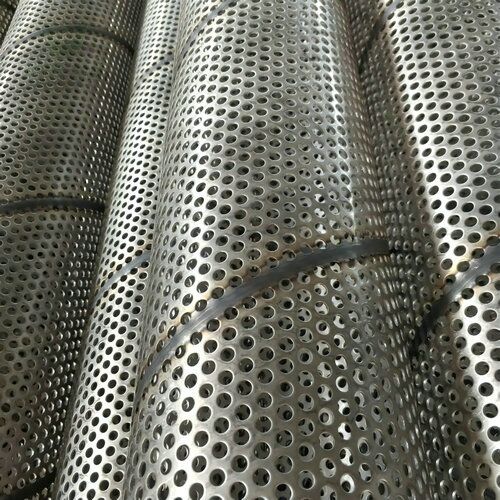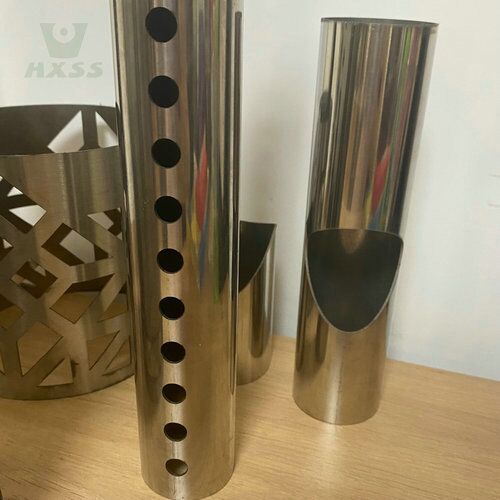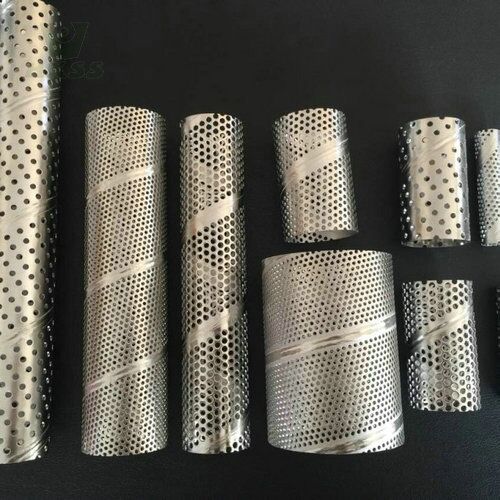Due to its excellent corrosion resistance and comprehensive performance, stainless steel perforated pipe can be completely recycled. Perforated stainless steel tubing has holes of various shapes – round, slotted square, straight, or staggered. You can choose to lock seam or welded fabrication for perforated tubing. The hole size can be customized according to your requirements. Looking forward to being one of your perforated stainless steel tube suppliers in China
Perforated Stainless Steel Tube
Perforated Stainless Steel Tubes Suppliers | Manufacturers | Exporters
Huaxiao is one of the large suppliers of high-quality perforated stainless steel tubes. Stainless steel perforated pipe in various standard sizes and grades. Stainless steel perforated pipes mainly include austenite evaluation during tempering and solidification, bright strengthening, and process coating of treated steels such as TP304, TP304L, TP316, TP316L, and TP201. Perforated stainless steel tubes help channel media create different channel components. Using perforated metal improves the quality and weight of channel flow.
The stainless steel 304 perforated tubes we offer are mostly used as auxiliary pipes in channel products and sometimes exclusively as channel cylinders and chambers in certain industries. As one of the perforated stainless steel pipe suppliers and manufacturers in China, we also perform well. Compared to the market cost, the cost of buying treated steel perforated pipes from us in China is the best.
Specifications of Perforated Stainless Steel Tube
Item | Perforated Stainless Steel Tube Pipes |
Grades | GB, AISI, ASTM, DIN, EN, SUS, UNS, etc Grade:304, SS 304, 304L, 316, 316L, 409, 2205, etc |
Perforated Stainless Steel Pipe OD | 1/8” NB to 24” NB, 1/4” OD to 24” OD sizes stainless steel welded tubes also available |
| Perforated Stainless Steel Tube | 0.2mm to 15mm |
| Size | 1 inch stainless steel tubing 12mm internal diameter steel tube |
| Manufacturer | Tisco steel, Posco steel, Bao steel, etc |
Shapes of Perforated Stainless Steel Tube
Perforated stainless steel tubes come in various shapes and configurations to meet specific application requirements. The choice of tube shape depends on factors such as the intended function, structural needs, and aesthetics. Here are some common shapes of perforated stainless steel tubes:
- Round Perforated Tubes: Round tubes are the most common shape for perforated stainless steel tubes. They are used in a wide range of applications, including filtration, ventilation, structural supports, and decorative elements. The perforations can be arranged in various patterns, such as staggered or straight rows.
- Square Perforated Tubes: Square tubes are often chosen for their structural stability. They are used in applications where square or rectangular perforations are preferred. Square perforated tubes are commonly used in construction, shelving, and fencing.
- Rectangular Perforated Tubes: Rectangular tubes are similar to square tubes but have longer sides, resulting in rectangular perforations. They are used in applications requiring a specific aspect ratio of the perforations or when a flat surface is needed.
- Hexagonal Perforated Tubes: Hexagonal tubes feature hexagon-shaped perforations. They are chosen for their unique appearance and can be used in architectural and decorative applications, as well as for filtration and ventilation purposes.
- Oval Perforated Tubes: Oval tubes have elongated, oval-shaped perforations. They are used when a more elliptical or decorative hole pattern is desired. Oval perforated tubes are often seen in architectural and ornamental designs.
- Slotted Perforated Tubes: Slotted tubes have long, narrow slots instead of traditional round or square holes. They are commonly used in drainage systems, screens, and filtration applications. Slotted tubes allow for the passage of fluids while minimizing the entry of solids.
- Spiral Perforated Tubes: Spiral tubes have a helical or spiral pattern of perforations along the length of the tube. They are used in applications where a continuous opening or unique flow pattern is required, such as in some filtration and fluid distribution systems.
- Custom Shapes: Perforated stainless steel tubes can also be customized to match specific shapes and patterns to meet unique design or functional requirements. Custom shapes can be tailored to architectural and artistic projects.
- Specialized Shapes: In addition to the above shapes, specialized shapes can be manufactured based on the specific needs of an application. These shapes can vary widely and depend on the intended purpose of the perforated tube.
The choice of shape depends on factors such as the intended function, aesthetics, structural requirements, and the flow of fluids or gases through the tube. Manufacturers often offer a range of options and customization to ensure that the perforated stainless steel tubes meet the precise specifications of their customers’ projects.
Perforated Stainless Steel Pipes Process
Perforated stainless steel pipes are used in various industrial applications for purposes such as filtration, drainage, and ventilation. The process of manufacturing perforated stainless steel pipes involves several steps. Here’s an overview of the typical process:
- Selection of Stainless Steel: The process begins with the selection of the appropriate grade of stainless steel. Stainless steel is chosen for its corrosion resistance, strength, and durability. Common grades used include 304 and 316 stainless steel.
- Perforation Pattern Design: The next step is designing the pattern of holes or perforations in the stainless steel pipe. The pattern can vary depending on the intended use of the pipe. Common perforation patterns include round holes, square holes, or custom patterns to meet specific requirements.
- Perforation: Perforation is the process of creating holes in the stainless steel pipe. There are several methods for perforating stainless steel, including:
- Punching: This involves using a punch press with a die and punch set to create holes in the stainless steel pipe. The size, shape, and spacing of the holes are determined by the die and punch design.
- Laser Cutting: Laser cutting uses a high-energy laser beam to cut precise holes in the stainless steel pipe. It is suitable for creating intricate perforation patterns.
- Drilling: For smaller-scale production or custom requirements, drilling can be used to create holes in the pipe. This method is slower than punching or laser cutting but can be effective for specialized applications.
- Deburring: After the perforations are created, the edges of the holes may have sharp burrs or rough edges. These need to be removed to ensure a smooth and safe surface. Deburring can be done through mechanical or chemical methods.
- Forming: In some cases, the perforated stainless steel pipe may need to be shaped or formed to meet specific design requirements. This can involve bending or curving the pipe.
- Cleaning and Passivation: To ensure the stainless steel remains corrosion-resistant, the perforated pipe is cleaned to remove any contaminants and then passivated. Passivation is a chemical process that removes surface impurities and enhances the stainless steel’s corrosion resistance.
- Quality Control: Throughout the manufacturing process, quality control checks are performed to ensure that the perforated stainless steel pipe meets the required specifications and standards.
- Packaging and Shipping: Once the perforated stainless steel pipes pass quality control, they are typically packaged and prepared for shipment to customers or downstream manufacturing processes.
It’s important to note that the specific manufacturing process may vary depending on the manufacturer, the type of stainless steel used, and the intended application of the perforated pipes. The steps mentioned above provide a general overview of the typical process involved in producing perforated stainless steel pipes.
Application Range of Perforated Stainless Steel Tubes
Perforated stainless steel tubes find a wide range of applications across various industries due to their versatility, durability, and excellent corrosion resistance. Here are some common application areas for perforated stainless steel tubes:
- Filtration and Separation: Perforated stainless steel tubes are widely used for filtration purposes. They can be used to filter liquids, gases, and solids in applications such as water treatment, oil and gas processing, chemical processing, and food and beverage production. The size and pattern of the perforations can be customized to achieve the desired filtration efficiency.
- Acoustic and Sound Control: Perforated stainless steel tubes are employed in acoustic applications where sound absorption or noise reduction is required. They are used in buildings, HVAC systems, automotive components, and industrial machinery to control noise levels.
- Ventilation and Air Distribution: Perforated tubes are used in HVAC (Heating, Ventilation, and Air Conditioning) systems to distribute air evenly while preventing the ingress of dust and debris. They can also be used in industrial exhaust systems for ventilation purposes.
- Architectural and Decorative Applications: Perforated stainless steel tubes are utilized in architectural and decorative elements for their aesthetic appeal and functionality. They can be incorporated into building facades, railings, balustrades, partitions, and interior design elements.
- Heat Exchangers: In heat exchangers, perforated stainless steel tubes are employed as part of the heat transfer system. They allow for efficient heat exchange between fluids, making them suitable for applications in power plants, chemical processing, and HVAC systems.
- Fluid Transport: Perforated stainless steel tubes can be used in fluid transport systems, particularly in corrosive environments. They are suitable for conveying a variety of liquids and gases in industries such as petrochemical, pharmaceutical, and food processing.
- Support and Structural Components: In some applications, perforated stainless steel tubes are used as structural elements or as supports for other equipment. Their strength and rigidity make them suitable for such purposes in construction and industrial settings.
- Automotive and Transportation: Perforated stainless steel tubes find applications in the automotive industry for exhaust systems and in transportation equipment like railings and handrails for buses and trains.
- Oil and Gas Industry: Perforated stainless steel tubes are used in the oil and gas sector for well screens, sand control screens, and casing liners to prevent the intrusion of sand and other particles while allowing the flow of hydrocarbons.
- Chemical Processing: These tubes are used in chemical processing equipment, including reactors, columns, and storage tanks, to facilitate various chemical processes while maintaining corrosion resistance.
- Food and Beverage Processing: In the food and beverage industry, perforated stainless steel tubes can be used for straining, filtering, and processing applications where sanitary and corrosion-resistant materials are essential.
- Environmental Protection: Perforated stainless steel tubes are employed in environmental applications, such as groundwater monitoring, landfill leachate collection, and air pollution control.
The application range of perforated stainless steel tubes is diverse, and their adaptability to different industries and environments makes them a popular choice for many engineering and manufacturing solutions. The specific design, size, and perforation pattern of the tubes can be tailored to suit the unique requirements of each application.
Export Package of Perforated Stainless Steel Tubes
Export packaging for Perforated Stainless Steel Pipe is essential to ensure that the product arrives at its destination intact and in compliance with international shipping standards. The following are typical export packaging pictures of perforated stainless steel pipes. If customers have other packaging needs, we can meet them.
Looking forward to becoming one of your perforated stainless steel pipe suppliers in China!



